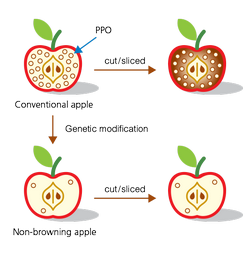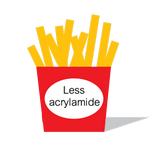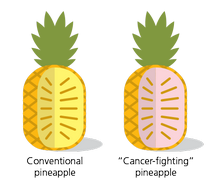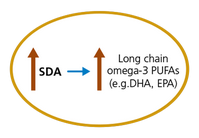Genetically Modified Food with Beneficial Features to Consumers
In 1994, the delayed-ripening tomato (Flavr-SavrTM) became the first commercialised genetically modified (GM) food crop. Since then, more than ten different types of GM food crops have been approved and commercialised around the world. These range from major commodities such as soya bean, corn and cotton to fruits and vegetables like papaya and eggplant. Most of these GM crops are designed to have resistance to diseases and insect damage, and tolerance to certain herbicides. These "first generation" GM crops primarily benefit farmers by reducing production cost and improving crop yield. Now, research is focused on "second generation" GM crops that produce added health and nutritional benefits for consumers. Although these GM crops may have more direct benefits to the general public, some people may still have concerns over their safety.
Non-browning apple
When apples are cut or sliced, it begins to brown quickly making it unappealing to apple consumers, especially children. Every year tons of apples end up in the trash due to the browning issue. There are many ways to keep cut apple from turning brown, for example, by coating with lemon juice, soaking in salt water, boiling, etc. However, all these methods affect the taste or texture of the apple.
To help reduce wastage and make it more convenient and appealing for consumers, a type of GM non-browning apple was developed by silencing the expression of an enzyme involved in the browning reaction, i.e. polyphenol oxidase (PPO). This GM apple produces virtually no PPO so that the enzymatic reaction will not occur and that the apple will not become brown when it is bitten, sliced; or otherwise bruised.
In March 2015, the US Food and Drug Administration completed its evaluation for two non-browning apples and concluded that these apples are as safe and nutritious as their conventional counterparts.

Figure 1. With polyphenol oxidase (PPO) shut down, the non-browning apple does not brown as conventional apples do.
Potato with bruise-resistance and reduced acrylamide-forming potential
Like apples, potatoes brown when they are cut and peeled. By silencing PPO in a similar way as in the non-browning apple, the newly developed GM potato stay white longer when cut or peeled and are less prone to pressure bruising during storage, resulting in less potato waste. In addition to the feature of bruise resistance, this GM potato is also engineered to produce lower levels of asparagine. Asparagine is an amino acid that is naturally found in many vegetables, and some varieties of potatoes have higher concentrations. When heated to a high temperature (e.g. by frying or baking) in the presence of certain sugars, asparagine can give rise to acrylamide - a probable carcinogen according to the International Agency for Cancer Research. The levels of acrylamide are reportedly 50 to 75 percent lower than that in comparable non-GM counterparts when the GM potatoes are fried. This GM potato provides a healthier option for consumers who wish to eat fried potato products and is expected to be available on the market in the near future.

Figure 2. GM potato claimed to generate less acrylamide upon frying.
"Heart-healthy" Soya bean
In recent years, increased intakes of long chain omega-3 polyunsaturated fatty acids (PUFAs) such as eicosapentaenoic acid (EPA) and docosahexaenoic acid (DHA) have been recommended by several national authorities to reduce the risk of cardiovascular disease. These recommendations can be achieved by consuming at least two fish meals per week. Despite these recommendations, fish intake is low in some western countries.
In response, researchers investigated whether plants could be used as sources of long chain omega-3 PUFAs. Therefore, soya bean was genetically modified to increase the content of stearidonic acid (SDA), an intermediate fatty acid in the metabolic pathway for the synthesis of long chain omega-3 PUFAs, so as to increase the levels of omega-3 PUFAs in the GM soya bean and its derived oil. This GM soya bean has gone through the safety assessment of a number of food safety authorities and has been approved for food use in the European Union, the US, Australia, Canada, Japan and Korea.
Figure 3. Level of stearidonic acid (SDA) in soya bean is increased through genetic modification to meet the need for dietary intake of long chain omega-3 polyunsaturated fatty acids.
"Cancer-fighting" pineapple
Lycopene is a naturally occurring substance that gives tomatoes their red colour. It is an antioxidant which may have a role in lowering the risk of certain cancers. To increase dietary intake of lycopene, pineapple is genetically engineered to accumulate lycopene in the edible tissue by overexpressing a gene derived from tangerine and suppressing two endogenous genes involved in the lycopene biosynthesis. The accumulation of lycopene gives the flesh a pink colour that allows the GM pineapple to be easily distinguished from its conventional counterparts.
Field testing of the GM pineapple is underway in Costa Rica. This new variety of pineapple will be allowed to be sold in the US market for food use if approval from US Food and Drug Administration is granted.

Figure 4. Pineapples were genetically modified to contain the antioxidant, lycopene, which helps lower the risk of certain cancers.
GM crops coming through the pipeline
In 2014, GM crops were planted in 28 countries and the area of planting has increased more than 100-fold from 1996 to 2014. In addition to the crops mentioned in this article other new GM crops that could directly benefit consumers, such as biofortified rice, allergen free nuts, and "heart-healthy" tomatoes (GM tomatoes with compounds that lower the risk of cardiovascular disease) are coming through the pipeline and may someday be on grocery shelves alongside the more traditional products.
